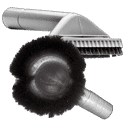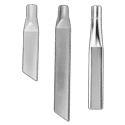Selecting the right commercial vacuum tool / accessory for the right job can make all the difference in the world when it comes to getting superior vacuuming results, in less time.
So, how do you choose the best vacuuming tool / accessory for any particular vacuuming job?
Well, depending on the type of job and flooring that you need to vacuum, here are six (6) categories of tools — and a brief explanation of WHERE & WHEN they are best used — to consider:
 #1: Vacuum Wands
#1: Vacuum Wands
There are two primary types of wands that can be used as attachments to the vacuums.
CURVED / “S” WANDS:
The curved wands are used primarily when you’re doing the more traditional type of vacuuming where you’re moving back and forth. They are used to get into the nooks and crannies of tighter spaces like around and in-between furniture.
The “S” wands give you an easy grip and easy access and can accommodate a large range of tools and attachments.
STRAIGHT WANDS:
The straight wands, on the other hand, are typically used for accessing places that are out of reach.
For example, using a telescopic straight wand will allow you to reach a vent in the ceiling that you can’t normally get to.
Straight wands have their applications, but they are also suitable for cleaning, wide-open spaces, or long corridors. Straight wands also accommodate a wide range of vacuum cleaning tools.
 #2: Dusting Brushes
#2: Dusting Brushes
Most people use a traditional form of dusting, which is using a wet cloth, microfiber pad, brush, or Swiffer to clear the dust off most surfaces.
A good alternative to the traditional method of dusting, however, is to use a dusting brush attached to a vacuum cleaner. This will not only agitate and push the dust off the surfaces but will also allow you to capture all the debris into the vacuum receptacle rather than redistributing the dust in the air.
Dusting brushes come in many shapes and sizes. Brushes with horsehair bristles are very soft and gentle and great to use on delicate surfaces that you are cleaning.
There are also dusting brushes that are available as upholstery tools that you can use to clean sofas, chairs, and cushions that might get dirty over time.
 #3: Crevice Tools
#3: Crevice Tools
Crevice tools are the perfect vacuum tool to clean hard-to-reach places like vents, behind radiators, or under low furniture.
Crevice tools come in different sizes and materials depending on your cleaning needs and are great in helping you reach the places that are otherwise ignored.
 #4: Smooth Surface Floor Tools
#4: Smooth Surface Floor Tools
Smooth surface vacuum tools essentially replace the need for a broom and are used to clean resilient floor surfaces such as VCT tiles, terrazzo, ceramic tiles, and hardwood.
Here are some of the different types of smooth surface tools to consider:
The smooth surface tool with Tampico bristles: This tool is the closest you’ll come to mimicking a broom and is typically used on bare concrete or hard floors.
The smooth surface tool with horsehair bristles: This tool is ideal for hardwood floors because the naturally soft bristles on the brush will ensure that the hardwood you are cleaning doesn’t get damaged.
The smooth surface tool with nylon bristles: These tools are slightly less expensive because they are made with synthetic materials. Nonetheless, they have a very similar function to the horsehair brush and can be used on more sensitive surfaces like hardwood.
The smooth surface tool made with felt: The felt tool is perfect for cleaning up very fine layers of dust. An example where a felt tool might be useful is when cleaning up after a construction job.
The smooth surface tool without any bristles is called the gulper tool. This tool is made of metal and has a wide mouth which makes it ideal for picking up larger debris that is often left behind after construction work, or in industrial facilities. Since there aren’t any bristles, this tool is best for concrete floors as opposed to sensitive surfaces like hardwood.
 #5: Carpet Cleaning Tools
#5: Carpet Cleaning Tools
When selecting tools for carpet cleaning, there are two things to consider.
The first is whether you are working with high-pile carpets or low-pile carpets.
The second is whether you are looking for a deeper clean, or a more surface quick clean.
High-pile carpets are usually found in residential settings as opposed to commercial spaces. In such cases, the best way to clean those carpets is to use a commercial-grade vacuum cleaner with an attached powerhead to get the best results.
For low-pile carpets which are typically more common in commercial spaces, it’s best to use a tool with bristles on it to get a “deeper” clean. The bristles will work to agitate the carpet and loosen the dirt that is trapped in the carpet fibers.
If you’re trying to achieve a quicker clean, you might consider a smooth surface carpet tool without bristles. These tools will allow you to easily glide over the carpet surface to clean it more quickly.
If you need to clean carpets that have liquid spills, you should consider a wet/dry carpet tool that will pick up the moisture from a saturated carpet. That way, you can quickly clean any accidental spills on carpeted surfaces. (When cleaning wet spills, be sure you’re ONLY using a wet/dry vacuum).
 #6: Liquid Pick-Up Tools
#6: Liquid Pick-Up Tools
When picking up liquids, the most important thing to use is a wet vac. Beyond that, however, there are different types of liquid pick-up tools that are ideal for different types of liquids.
For example, if you are dealing with a general wet pickup, whether it’s melted snow or a smaller water spill, a standard squeegee tool will effectively get the job done.
However, if you are dealing with chemical or oil spills, you can choose to equip your squeegee with blades that are oil and chemical-resistant. Let’s say you’ve just finished a floor stripping job for example, and you have stripper chemical, wax, and dirt mixed, you might want to get a chemical resistant blade on your squeegee so that it lasts longer.
An improvement of the general squeegee is a squeegee tool with wheels. This allows you to adjust the squeegee to the right height so that you will glide across the surface more easily and not get stuck while cleaning up liquid spills.
Finally, you can also choose to have tools that are integrated for multiple types of jobs.
All-in-one tools, for example, allow you to put in squeegee blades, brushes, and regular blades to clean smooth floors, carpets as well as liquid spills – all with the same tool.
Pro Tip Commercial Cleaners
In addition to the tools mentioned above for commercial cleaning, if you are also considering residential work where you may have to clean a high-pile carpet, select a commercial vacuum that has an onboard power receptacle so you can attach a power brush.
This will allow you to connect your power brush (powerhead) to the vacuum cleaner and ensure you can “deep clean” carpets efficiently and quickly.